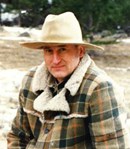Kirk Malcolm Horn
1939 – 2019

Kirk M. Horn, 79, passed away on Sunday February 10, 2019, in Billings, Montana, where he was being treated for cancer. He was surrounded by family he loved.
Kirk was born in Eugene, Oregon, and grew up on the family farm where his childhood was one of hard work, love, and lots of outdoor activities. He completed college at Lewis and Clark College in Washington and Pacific University in Oregon and attended graduate school at the University of Arizona with degrees in biology. He loved large mammals, the outdoors, and believed in taking care of the environment.
Kirk worked summers at Crater Lake National Park where he met his wife Beth and they enjoyed over 50 years of marriage. He taught biology at Heppner High School in Oregon where he thoroughly enjoyed his students and watched them grow into young adults. He then went on to a rewarding career with the U.S. Forest Service where he held positions as forest biologist on the Mt Hood National Forest in Oregon, regional wildlife biologist in Portland, Oregon, national threatened and endangered species coordinator in Washington D.C., and regional director of wildlife and fisheries in Missoula, Montana. He and Beth retired in 1999, settling in a home on the shores of Hebgen Lake where they could enjoy hiking, camping, fishing, and other outdoor activities that they loved. Kirk continued working on wildlife issues after retirement and was President of the Board of Directors at the Grizzly and Wolf Discovery Center for many years. He always found it a source of pride and esteem to be able to teach people about the wild animals he so loved.
Kirk is survived by wife Beth, daughter Frances Malcolm (Greg) Charnesky, and grandsons Owen and Matthew. Donations may be made in Kirk’s name to the Grizzly and Wolf Discovery Center in West Yellowstone.
Published in Bozeman Daily Chronicle on Mar. 13, 2019
From CLI’s Larry Smith, long-time ranger at Crater Lake:
Beth, Sorry to hear about Kirk’s passing. I remember his as a very young, enthusiastic, bouncy “kid” when he showed up at Crater Lake. So much energy. And he was a dedicated photographer. If I remember right I think he took the photos for your books.
I went through my CL history collection and found this entry:
July 1968 Ranger Nancy Jarrell and a group of Park employees investigate the North Junction Cave. The cave had been uncovered when the North Road was built back in the 20’s. For over 40 years the lava tube cave had been covered over by planks. Nancy crawls and slithers 500 feet into the lava tube. After getting cold and wet, the group turns around. Nancy reports that the cave showed no evidence of ending. The Park’s road crew later plugs the cave’s entrance with a truckload of rock.
From geologist Charlie Bacon – October 17, 2015 – I recall hearing something about this cave long ago. I’d be surprised it was technically a lava tube, given that it must be in Llao Rock rhyodacite. It more likely would be an extensional fracture in the lava, or possibly where the lava flowed over snow or even ice that subsequently melted out. True lava tubes are conduits within solidified lava flows for flowing lava that can become caves when lava drains from them, most commonly in basalt.
From Beth Horn – October 17, 2015 – Thanks for the quick response. Both Kirk and I recall exploring it during the summer of 1965. Nancy’s recall is correct – you had to slither because the entry was very small! I don’t recall anyone calling it a lava tube at the time, but not sure what it was called. When I went in there were several Park naturalists in the group. There were planks covering the entrance.
Crater Lake National Park: Geologic Resources Management Issues Scoping SummaryCaves: There are over 40 caves in the park that have not been inventoried and mapped. One cave was closed by the development of a road. There is a need for research on bats and other fauna. The park should work with the National Speleological Society (NSS) to develop a program of systematic inventory and research of the caves.
- Crater Lake Centennial Celebration oral histories
- Hartzog – Complete Interview (PDF)
- Jon Jarvis
- Albert Hackert and Otto Heckert
- Hazel Frost
- James Kezer
- F. Owen Hoffman
- Douglas Larson
- Carroll Howe
- Wayne R. Howe
- Francis G. Lange
- Lawrence Merriam C.
- Marvin Nelson
- Doug and Sadie Roach
- James S. Rouse
- John Salinas
- Larry Smith
- Earl Wall
- Donald M. Spalding
- Wendell Wood
- John Lowry Dobson
- O. W. Pete Foiles
- Bruce W. Black
- Emmett Blanchfield
- Ted Arthur
- Robert Benton
- Howard Arant
- John Eliot Allen
- Mabel Hedgpeth

